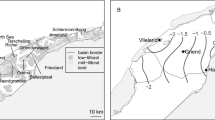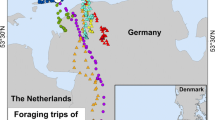Abstract
We studied the behavior of gulls at night with an image intensifier telescope to determine whether they were active at night, and the extent of their foraging in coastal habitats of New Jersey in the summer, fall, and winter of 1989–1990. Regression models and Kruskal-Wallis tests indicated that date, time of day, tide, cloud cover, moon phase, and study location all influenced variations in the presence and nocturnal activities of gulls. For each site and species, an, average of 48–88% of the nocturnal surveys recorded gulls foraging or flying about. More laughing gulls (Larus atricilla) foraged at night at Brigantine Beach compared to ring-billed gulls (L. delawarensis) at the northern New Jersey sites. However, more gulls were flying about at the Raritan River site compared to the other places. We suggest that more laughing gulls fed at night compared to ring-billed gulls because the former were breeding. Breeding gulls spend half their time incubating or caring for chicks, and thus might have time constraints on foraging during the day. Laughing gulls foraged at all times of the night on some surveys, but were more frequent around midnight, and the number of flying laughing gulls decreased after 0200 hours. Ring-billed gulls, however, seemed to be equally active all night. Our data indicate that gulls can be active all night, and in all habitats.
Similar content being viewed by others
Literature Cited
Blockpoel, H. 1976. Bird Hazards to Aircraft. Books Canada, Buffalo, New York. 235 p.
Burger, J. 1976. Daily and seasonal activity patterns in breeding laughing gulls. Auk 93:308–323.
Burger, J. 1981. Feeding competition between laughing gulls and herring gulls at a sanitary landfill. Condor 83:328–335.
Burger, J. 1983. Bird control at airports. Environmental Conservation 10:115–124.
Burger, J. 1984. Abiotic factors affecting migrant shorebirds, p. 1–73. In, J. Burger and B. L. Olla (eds.), Behavior of Marine Animals. Vol. 6. Shorebirds: Migration and Foraging Behavior. Plenum Press, New York.
Burger, J. 1988. Foraging behavior of gulls: Differences in habitats, prey hens and foraging methods. Colonial Waterbirds 11:9–23.
Burger, J. 1991. Foraging behavior and the effects of human disturbance on the piping plover (Charadrius melodus). Journal of Coastal Research 7:39–52.
Burger, J. and M. Gochfeld. 1990. The Black Skimmer: Social Dynamics of a Colonial Species. Columbia University Press, New York.
Burger, J. and M. Gochfeld. 1991. Human activity influence and diurnal and nocturnal foraging of sanderling (Calidris alba). Condor 93:259–267.
Delius, J. D. 1970. The effect of daytime, tides, and other factors on some activities of lesser black-backed gulls, Larus fuscus. Revue Comporte Animale 4:3–11.
Drent, R. H. 1967. Functional aspects of incubation in the herring gull (Larus argentatus Pont.). Behaviour Supplement 17.
Dugan, P. J. 1981. The importance of nocturnal foraging in shorebirds: A consequence of increased invertebrate activity, p. 251–260. In: N. V. Jones and W. J. Wolff, (eds.) Feeding Strategies of Estuarine Organisms. Plenum Press, New York.
Erwin, R. M. 1979. Species interactions in a mixed species colony of common terns (Sterna hirundo) and black skimmers (Rynchops niger). Animal Behavior 27:1054–1062.
Fetterolf, P. M. 1979. Nocturnal behaviour of ring-billed gulls during the early incubation period. Canadian Journal of Zoology 57:1190–1195.
Galusha, J. C. Jr., and C. J. Amlaner, Jr 1978. The effects of diurnal and tidal periodicities in the numbers and activities of herring gulls (Larus argentatus) in a colony. Ibis 120:322–328.
Kalas, J. A. 1986. Incubation schedules in different parental care systems in the dotterel (Charadius morinellus). Ardea 74: 185–190.
McNeil, R. and M. Robert. 1988. Nocturnal feeding strategies of some shorebird species in a tropical environment, p. 2328–2336. In H. Ouellet (ed.), 19th International Ornithological Congress. University of Ottawa Press, Ottawa, Canada.
Pienkowski, M. W. 1982. Diet and energy intake of grey and ringed plovers in the non-breeding season. Journal of Zoology (London) 197:511–547.
Robert, M. and R. McNeil. 1988. Comparative day and night feeding strategies of shorebird species in a tropical environment. Ibis 131:69–79.
Robert, M. and R. McNeil. 1989. Night activity in the brown pelican. Colonial Waterbirds 12:118–119.
Robert, M., R. McNeil, and A. Leduc. 1989. Conditions and significance of night feeding in shorebirds and other waterbirds in a tropical lagoon. Auk 106:94–101.
SAS. 1985. User’s Guide: Statistics. SAS Institute, Inc., Cary, North Carolina.
Southern, L. K. and W. E. Southern. 1979. Absence of nocturnal predator defense mechanisms in breeding gulls. Colonial Waterbirds 3:27–32.
Southern, W. E., S. R. Patton, L. K. Southern, and L. A. Hanners. 1985. Effects of nine years of fox predation on two species of breeding gulls. Auk 102:827–833.
Wetmore, A. 1919. The pupil of the black skimmer. Proceedings of the Biology Survey of Washington 32:195–202.
Zusi, R. L. 1962. Structural adaptations of the head and neck in the black skimmer. Proceeding Nuttall Ornithological Club, Cambridge, Massachusetts.
Author information
Authors and Affiliations
Rights and permissions
About this article
Cite this article
Burger, J., Staine, K.J. Nocturnal behavior of gulls in coastal New Jersey. Estuaries 16, 809–814 (1993). https://doi.org/10.2307/1352439
Received:
Accepted:
Issue Date:
DOI: https://doi.org/10.2307/1352439




